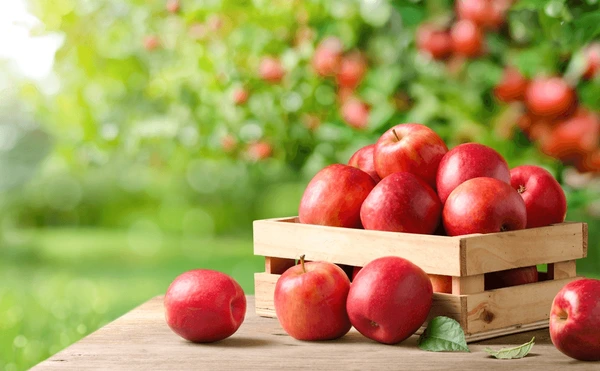India’s apple market is facing a double shock: Kashmir’s dominance as the country’s key apple-growing region is threatened by an aggressive pest outbreak, while grower expenses continue to climb due to increased pesticide use and intensive orchard management. The apple blotch leaf miner—a pest likely introduced through unregulated imports of high-density rootstock from Italy and other countries—has spread rapidly since its first detection near Zainapora in 2019-20. The result? Widespread damage across south Kashmir and mounting concern about outbreaks elsewhere.
With Kashmir accounting for 75% of India’s total apple output (around 2.5–2.6 million tones annually), the implications for both regional livelihoods and national fruit supplies are profound. Unless strict quarantine protocols are implemented, experts warn that continued unchecked pest introductions could put both yield and quality at risk, threatening a market that supports millions and which plays a key role in rural incomes. Meanwhile, the government’s push for high-density apple cultivation—with generous subsidies—risks compounding the region’s phytosanitary vulnerabilities. As the global trade in apples and dried apple products weathers supply chain strains from India’s production worries, prices remain steady but are increasingly exposed to upward pressure. Producers and importers alike will be watching weather patterns, pest management trends, and regulatory responses closely over the coming months.
Exclusive Offers on CMBroker

Apple dried
Cubes 10-12 mm
FCA 4.25 €/kg
(from NL)

Apple dried
Cubes 8-10 mm
FCA 4.20 €/kg
(from NL)

Apple dried
Cubes 5-7 mm
FCA 4.30 €/kg
(from NL)
📈 Apple Prices and Market Sentiment
| Product | Type | Origin | Location | Price (€/kg) | Weekly Change | Market Sentiment |
|---|---|---|---|---|---|---|
| Apple dried | Cubes 5-7 mm | China | Dordrecht, NL | 4.75 | 0.00 | Neutral/Watchlist |
| Apple dried | Cubes 8-10 mm | China | Dordrecht, NL | 4.65 | 0.00 | Neutral/Watchlist |
| Apple dried | Cubes 10-12 mm | China | Dordrecht, NL | 4.72 | 0.00 | Neutral/Watchlist |
🌍 Supply & Demand Dynamics
- Kashmir’s Crisis: The region, which provides over 75% of India’s apples, faces up to 10–20% yield cuts where infestations are severe, compounding supply-side vulnerability.
- Production Comparison: India ranks among the top five global apple producers. However, the new pest episode is expected to tighten regional supply and support international demand for import alternatives—especially from China and Europe.
- Pesticide/Management Costs: Orchardists are applying more sprays and implementing intensive management, increasing input costs and potentially affecting margins and market prices for the next harvest cycle.
- Demand Steady: Domestic consumption remains strong, and the demand for apple-based processed products, such as dried cubes, is stable in Europe and Asia.
📊 Market Fundamentals & External Drivers
- Quarantine Policy Gaps: Lack of strict controls on imported high-density rootstocks is the suspected vector for pest introduction. Calls for tighter enforcement are mounting.
- High-density Plantation Push: The government aims to expand high-density apple cultivation under a major subsidy scheme—raising both production potential and phytosanitary risk.
- Input Inflation: Rising chemical and labor costs are feeding through to producer margins, likely to encourage further price resilience or gradual increases, especially if pest pressures persist.
- Global Signals: China (major apple/dried apple supplier) maintains stable output and prices, offsetting some Indian supply worries in the international processed goods market.
🌦️ Weather Outlook in Key Regions
- Kashmir: Current weather is seasonal, but above-average rainfall expected in the next 3 days could further stress pest-damaged trees—potentially increasing fruit drop in susceptible orchards.
- Europe (Poland, Italy): Main apple-producing regions benefit from mild, stable weather. Good growing conditions support crop health, mitigating supply risk in European markets.
- China: No extreme weather alerts—production remains steady.
Yield Impact: In Kashmir, the combination of pest stress and possible weather extremes over the coming weeks remains a key downside risk for late-season apple yields.
🌐 Global Production & Stock Comparison
| Country | 2023 Estimated Production (million tonnes) |
Major Export/Import Status |
|---|---|---|
| China | 44.0 | Top Exporter/Stable |
| India (Kashmir core) | 2.5 – 2.6 | Exporter/Domestic focus |
| Poland | 4.7 | Major Exporter |
| USA | 4.3 | Exporter |
| Italy | 2.4 | Exporter |
| Russia | 1.8 | Importer |
📅 Trading Outlook & Recommendations
- 🔎 Monitor weather and pest trends in Kashmir for potential late-harvest disruptions and short-term price volatility.
- 📤 Importers secure contracts early for dried/processed apple products to hedge against possible supply tightening from India.
- 🚫 Advocate for quarantine-enforced high-density plant imports—a step vital for long-term orchard health and stable supply.
- 💰 Expect steady or firmer prices in the next quarter if Kashmir’s crop damage estimates rise.
- 🌎 Watch for substitution from China and Poland if Indian supplies continue to be constrained.
- 📈 Diversify sourcing for processed apples to mitigate supply disruption risks.
⏩ 3-Day Regional Price Forecast
- NL (Dordrecht, FCA, China origin dried apple cubes): €4.65–4.75/kg (stable to slightly firm bias)
- India Domestic: Firm to higher, with local fresh apple prices expected to increase by 2–4% due to pest worries and input cost inflation
- Europe (Poland, Italy): Stable as weather and output remain favorable


